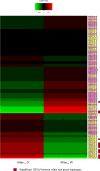Transcriptome analysis of Asparagus officinalis reveals genes involved in the biosynthesis of rutin and protodioscin
- PMID: 31329616
- PMCID: PMC6645489
- DOI: 10.1371/journal.pone.0219973
Transcriptome analysis of Asparagus officinalis reveals genes involved in the biosynthesis of rutin and protodioscin
Abstract
Garden asparagus (Asparagus officinalis L.) is a popular vegetable cultivated worldwide. The secondary metabolites in its shoot are helpful for human health. We analyzed A. officinalis transcriptomes and identified differentially expressed genes (DEGs) involved in the biosynthesis of rutin and protodioscin, which are health-promoting functional compounds, and determined their association with stem color. We sequenced the complete mRNA transcriptome using the Illumina high-throughput sequencing platform in one white, three green, and one purple asparagus cultivars. A gene set was generated by de novo assembly of the transcriptome sequences and annotated using a BLASTx search. To investigate the relationship between the contents of rutin and protodioscin and their gene expression levels, rutin and protodioscin were analyzed using high-performance liquid chromatography. A secondary metabolite analysis using high-performance liquid chromatography showed that the rutin content was higher in green asparagus, while the protodioscin content was higher in white asparagus. We studied the genes associated with the biosynthesis of the rutin and protodioscin. The transcriptomes of the five cultivars generated 336 599 498 high-quality clean reads, which were assembled into 239 873 contigs with an average length of 694 bp, using the Trinity v2.4.0 program. The green and white asparagus cultivars showed 58 932 DEGs. A comparison of rutin and protodioscin biosynthesis genes revealed that 12 of the 57 genes associated with rutin and two of the 50 genes associated with protodioscin showed more than four-fold differences in expression. These DEGs might have caused a variation in the contents of these two metabolites between green and white asparagus. The present study is possibly the first to report transcriptomic gene sets in asparagus. The DEGs putatively involved in rutin and protodioscin biosynthesis might be useful for molecular engineering in asparagus.
Conflict of interest statement
The authors have declared that no competing interests exist.
Figures







References
-
- Pontaroli AC, Camadro EL. Somaclonal variation in Asparagus officinalis plants regenerated by organogenesis from long-term callus cultures. Genetics and Molecular Biology. 2005; 28: 423–430.
-
- Kim BY, Cui ZG, Lee SR, Kim SJ, Kang HK, Lee YK et al. Effects of Asparagus officinalis extracts on liver cell toxicity and ethanol metabolism. Journal of food science. 2009; 74. - PubMed
-
- Bousserouel S, Le Grandois J, Gossé F, Werner D, Barth SW, Marchioni E et al. Methanolic extract of white asparagus shoots activates TRAIL apoptotic death pathway in human cancer cells and inhibits colon carcinogenesis in a preclinical model. International journal of oncology. 2013; 43: 394–404. 10.3892/ijo.2013.1976 - DOI - PMC - PubMed
-
- Fuentes-Alventosa J, Jaramillo-Carmona S, Rodríguez-Gutiérrez G, Rodríguez-Arcos R, Fernández-Bolaños J, Guillén-Bejarano R et al. Effect of the extraction method on phytochemical composition and antioxidant activity of high dietary fibre powders obtained from asparagus by-products. Food Chemistry. 2009; 116: 484–490.
Publication types
MeSH terms
Substances
LinkOut - more resources
Full Text Sources

